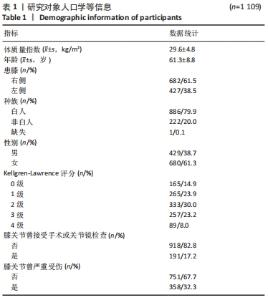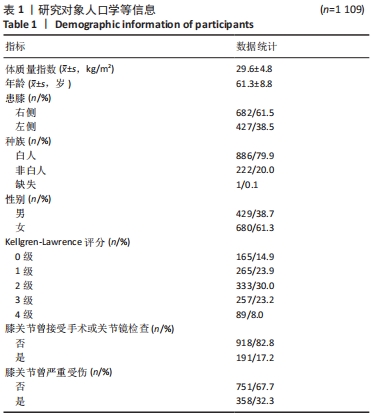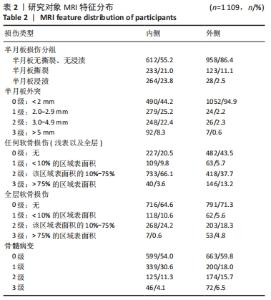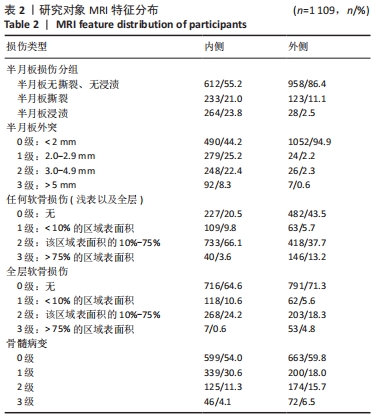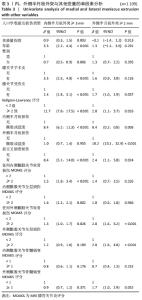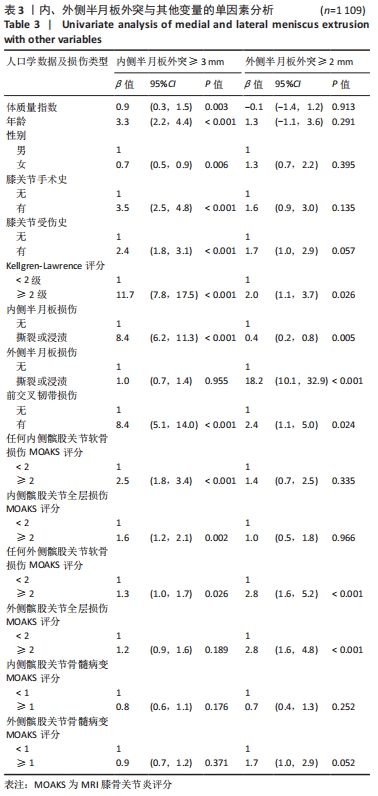Chinese Journal of Tissue Engineering Research ›› 2023, Vol. 27 ›› Issue (4): 600-605.doi: 10.12307/2022.962
Previous Articles Next Articles
Meniscus extrusion and patellofemoral joint cartilage injury and bone marrow lesions: MRI semi-quantitative score
Guo Yingqi, Gong Xianxu, Zhang Yan, Xiao Han, Wang Ye, Gu Wenguang
- Department of Traumatic Orthopedics, The First Affiliated Hospital of Harbin Medical University, Harbin 150001, Heilongjiang Province, China
-
Received:2021-11-18Accepted:2022-01-07Online:2023-02-08Published:2022-06-23 -
Contact:Gu Wenguang, MD, Chief physician, Department of Traumatic Orthopedics, The First Affiliated Hospital of Harbin Medical University, Harbin 150001, Heilongjiang Province, China -
About author:Guo Yingqi, Master candidate, Department of Traumatic Orthopedics, The First Affiliated Hospital of Harbin Medical University, Harbin 150001, Heilongjiang Province, China
CLC Number:
Cite this article
Guo Yingqi, Gong Xianxu, Zhang Yan, Xiao Han, Wang Ye, Gu Wenguang. Meniscus extrusion and patellofemoral joint cartilage injury and bone marrow lesions: MRI semi-quantitative score[J]. Chinese Journal of Tissue Engineering Research, 2023, 27(4): 600-605.
share this article
Add to citation manager EndNote|Reference Manager|ProCite|BibTeX|RefWorks
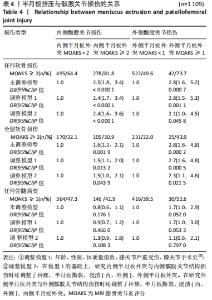
2.3 Logistics回归分析结果 半月板外突与髌股关节损伤的关系:横断面研究分析显示,内、外侧半月板外突人群的内、外侧髌股关节中的任何软骨损伤、全层软骨损伤、骨髓病变发生率较高。Logistics回归分析在调整混杂因素后(调整模型2),内侧半月板外突与内侧髌股关节任何软骨损伤[OR:2.4(95% CI:1.6,3.6)]、全层软骨损伤[OR:1.5(95% CI:1.0,2.1)]呈正相关,即有内侧半月板外突发生内侧髌股关节任何软骨损伤和全层软骨损伤的风险分别是无内侧半月板外突的2.4倍和1.5倍。在未调整[OR:0.8(95% CI:0.6,1.1)]与调整混杂因素后[OR:1.3(95% CI:0.9,1.8)],内侧半月板外突与内侧髌股关节骨髓病变均无相关。在调整混杂因素后(调整模型2),外侧半月板外突与外侧髌股关节任何软骨损伤[OR:2.1(95% CI:1.0,4.5)]、全层软骨损伤[OR:2.3(95% CI:1.1,4.6)]呈正相关,即有外侧半月板外突发生外侧髌股关节任何软骨损伤和全层软骨损伤的风险分别是无外侧半月板外突的2.1倍和2.3倍。在未调整混杂因素时[OR:1.7(95% CI:1.0,2.9)],外侧半月板外突与外侧髌股关节骨髓病变呈正相关,在调整混杂因素后[OR:1.1(95% CI:0.6,2.1)]两者无相关。相对于低于内侧半月板外突阈值(< 3 mm),内侧半月板外突人群中内侧髌股关节任何软骨损伤、全层软骨损伤发生率较高,骨髓病变的发生率较低。相对于低于外侧半月板外突阈值(< 2 mm),外侧半月板外突人群中外侧髌股关节任何软骨损伤、全层软骨损伤、骨髓病变发生率较高,见表4。"
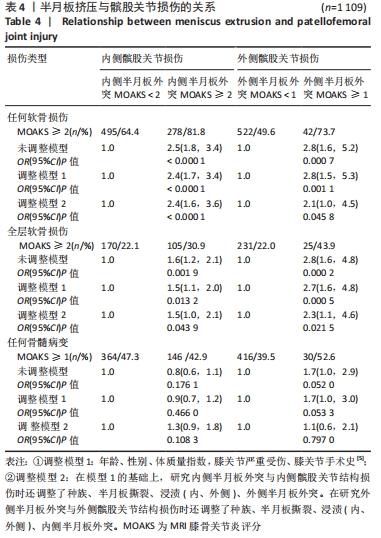
| [1] SHARMA L. Osteoarthritis of the Knee. N Engl J Med. 2021;384(1):51-59. [2] ENGLUND M, ROEMER FW, HAYASHI D, et al. Meniscus pathology, osteoarthritis and the treatment controversy. Nat Rev Rheumatol. 2012;8(7):412-419. [3] POULSEN E, GONCALVES GH, BRICCA A, et al. Knee osteoarthritis risk is increased 4-6 fold after knee injury - a systematic review and meta-analysis. Br J Sports Med. 2019;53(23):1454-1463. [4] 国家老年疾病临床医学研究中心(湘雅医院),中华医学会骨科学分会关节外科学组.中国髌股关节骨关节炎诊疗指南(2020年版)[J].中华骨科杂志,2020,40(18):1227-1234. [5] HART HF, CROSSLEY KM, FELSON D, et al. Relation of meniscus pathology to prevalence and worsening of patellofemoral joint osteoarthritis: the Multicenter Osteoarthritis Study. Osteoarthritis Cartilage. 2018;26(7):912-919. [6] ANTONY B, DRIBAN JB, PRICE LL, et al. The relationship between meniscal pathology and osteoarthritis depends on the type of meniscal damage visible on magnetic resonance images: data from the Osteoarthritis Initiative. Osteoarthritis Cartilage. 2017;25(1):76-84. [7] CHIBA D, SASAKI E, OTA S, et al. US detection of medial meniscus extrusion can predict the risk of developing radiographic knee osteoarthritis: a 5-year cohort study. Eur Radiol. 2020;30(7):3996-4004. [8] SWAMY N, WADHWA V, BAJAJ G, et al. Medial meniscal extrusion: Detection, evaluation and clinical implications. Eur J Radiol. 2018;102: 115-124. [9] EVERHART JS, MAGNUSSEN RA, ABOULJOUD MM, et al. Meniscus tears accelerate joint space loss and lateral meniscal extrusion increases risk of knee arthroplasty in middle-aged adults. J Orthop Res. 2020;38(11):2495-2504. [10] LIU Y, DU G, LI X. Threshold for lateral meniscal body extrusion on MRI in middle-aged and elderly patients with symptomatic knee osteoarthritis. Diagn Interv Imaging. 2020;101(10):677-683. [11] LANKHORST NE, DAMEN J, OEI EH, et al. Incidence, prevalence, natural course and prognosis of patellofemoral osteoarthritis: the Cohort Hip and Cohort Knee study. Osteoarthritis Cartilage. 2017;25(5):647-653. [12] KOBAYASHI S, PAPPAS E, FRANSEN M, et al. The prevalence of patellofemoral osteoarthritis: a systematic review and meta-analysis. Osteoarthritis Cartilage. 2016;24(10):1697-1707. [13] HART HF, STEFANIK JJ, WYNDOW N, et al. The prevalence of radiographic and MRI-defined patellofemoral osteoarthritis and structural pathology: a systematic review and meta-analysis. Br J Sports Med. 2017;51(16):1195-1208. [14] LI Z, LIU Q, ZHAO C, et al. High prevalence of patellofemoral osteoarthritis in China: a multi-center population-based osteoarthritis study. Clin Rheumatol. 2020;39(12):3615-3623. [15] PETERFY CG, SCHNEIDER E, NEVITT M. The osteoarthritis initiative: report on the design rationale for the magnetic resonance imaging protocol for the knee. Osteoarthritis Cartilage. 2008;16(12):1433-1441. [16] HUNTER DJ, GUERMAZI A, LO GH, et al. Evolution of semi-quantitative whole joint assessment of knee OA: MOAKS (MRI Osteoarthritis Knee Score). Osteoarthritis Cartilage. 2011;19(8):990-1002. [17] COLLINS JE, LOSINA E, NEVITT MC, et al. Semiquantitative Imaging Biomarkers of Knee Osteoarthritis Progression: Data From the Foundation for the National Institutes of Health Osteoarthritis Biomarkers Consortium. Arthritis Rheumatol. 2016;68(10):2422-2431. [18] 刘新光,丁冉,刘晨,等.内侧半月板半脱位的相关因素分析[J].中国矫形外科杂志,2021,29(6):503-506. [19] KOHN MD, SASSOON AA, FERNANDO ND. Classifications in Brief: Kellgren-Lawrence Classification of Osteoarthritis. Clin Orthop Relat Res. 2016;474(8):1886-1893. [20] STEFANIK JJ, GUERMAZI A, ROEMER FW, et al. Changes in patellofemoral and tibiofemoral joint cartilage damage and bone marrow lesions over 7 years: the Multicenter Osteoarthritis Study. Osteoarthritis Cartilage. 2016;24(7):1160-1166. [21] STEFANIK JJ, NIU J, GROSS KD, et al. Using magnetic resonance imaging to determine the compartmental prevalence of knee joint structural damage. Osteoarthritis Cartilage. 2013;21(5):695-699. [22] TREPCZYNSKI A, KUTZNER I, KORNAROPOULOS E, et al. Patellofemoral joint contact forces during activities with high knee flexion. J Orthop Res. 2012;30(3):408-415. [23] 雷光华.髌股关节骨关节炎的诊疗现状[J].医学临床研究,2020, 37(5):641-645. [24] BLOECKER K, WIRTH W, GUERMAZI A, et al. Longitudinal change in quantitative meniscus measurements in knee osteoarthritis--data from the Osteoarthritis Initiative. Eur Radiol. 2015;25(10):2960-2968. [25] LEE TQ, MORRIS G, CSINTALAN RP. The influence of tibial and femoral rotation on patellofemoral contact area and pressure. J Orthop Sports Phys Ther. 2003;33(11):686-693. [26] COLLINS NJ, BARTON CJ, VAN MIDDELKOOP M, et al. 2018 Consensus statement on exercise therapy and physical interventions (orthoses, taping and manual therapy) to treat patellofemoral pain: recommendations from the 5th International Patellofemoral Pain Research Retreat, Gold Coast, Australia, 2017. Br J Sports Med. 2018; 52(18):1170-1178. [27] MILLS K, HUNTER DJ. Patellofemoral joint osteoarthritis: an individualised pathomechanical approach to management. Best Pract Res Clin Rheumatol. 2014;28(1):73-91. [28] GUO W, LIU S, ZHU Y, et al. Advances and Prospects in Tissue-Engineered Meniscal Scaffolds for Meniscus Regeneration. Stem Cells Int. 2015;2015:517520. [29] PALETTA GA JR, CRANE DM, KONICEK J, et al. Surgical Treatment of Meniscal Extrusion: A Biomechanical Study on the Role of the Medial Meniscotibial Ligaments With Early Clinical Validation. Orthop J Sports Med. 2020;8(7):2325967120936672. [30] OLLIVIER B, BERGER P, DEPUYDT C, et al. Good long-term survival and patient-reported outcomes after high tibial osteotomy for medial compartment osteoarthritis. Knee Surg Sports Traumatol Arthrosc. 2021;29(11):3569-3584. [31] ASTUR DC, NOVARETTI JV, GOMES ML, et al. Medial Opening Wedge High Tibial Osteotomy Decreases Medial Meniscal Extrusion and Improves Clinical Outcomes and Return to Activity. Orthop J Sports Med. 2020;8(4):2325967120913531. [32] OTSUKI S, MURAKAMI T, OKAMOTO Y, et al. Hybrid high tibial osteotomy is superior to medial opening high tibial osteotomy for the treatment of varus knee with patellofemoral osteoarthritis. Knee Surg Sports Traumatol Arthrosc. 2019;27(4):1332-1338. [33] PETERFY CG, GUERMAZI A, ZAIM S, et al. Whole-Organ Magnetic Resonance Imaging Score (WORMS) of the knee in osteoarthritis. Osteoarthritis Cartilage. 2004;12(3):177-190. [34] CREMA MD, ROEMER FW, FELSON DT, et al. Factors associated with meniscal extrusion in knees with or at risk for osteoarthritis: the Multicenter Osteoarthritis study. Radiology. 2012;264(2):494-503. |
| [1] | Wan Guoli, Shi Chenhui, Wang Weishan, Li Ang, Shi Xunda, Cai Yi. Retrospective analysis of the influencing factors of chronic pain after total knee arthroplasty [J]. Chinese Journal of Tissue Engineering Research, 2023, 27(4): 558-564. |
| [2] | Liu Hao, Yang Hongsheng, Zeng Zhimou, Wang Liping, Yang Kunhai, Hu Yongrong, Qu Bo. Lumbar MRI vertebral bone quality score to evaluate the severity of osteoporosis in postmenopausal women [J]. Chinese Journal of Tissue Engineering Research, 2023, 27(4): 606-611. |
| [3] | Wu Tong, Yin Caiyun, Zhao Mingzhe, Zhu Yishen. Application of functional peptides for biomedical diagnosis [J]. Chinese Journal of Tissue Engineering Research, 2023, 27(3): 478-485. |
| [4] | Xie Pingjin, Luo Zhen, Lu Qigui, Guo Yanxing, Chen Qunqun, Li Feilong. Effect of ligustrazine and overexpression of miR-20b-5p on synovial, cartilage and subchondral bone angiogenesis in rats with early-stage knee osteoarthritis: a histological observation [J]. Chinese Journal of Tissue Engineering Research, 2023, 27(2): 237-245. |
| [5] | He Junjun, Huang Zeling, Hong Zhenqiang. Interventional effect of Yanghe Decoction on synovial inflammation in a rabbit model of early knee osteoarthritis [J]. Chinese Journal of Tissue Engineering Research, 2022, 26(5): 694-699. |
| [6] | Lin Xuchen, Zhu Hainian, Wang Zengshun, Qi Tengmin, Liu Limin, Suonan Angxiu. Effect of xanthohumol on inflammatory factors and articular cartilage in a mouse mode of osteoarthritis [J]. Chinese Journal of Tissue Engineering Research, 2022, 26(5): 676-681. |
| [7] | Zhang Tong, Cai Jinchi, Yuan Zhifa, Zhao Haiyan, Han Xingwen, Wang Wenji. Hyaluronic acid-based composite hydrogel in cartilage injury caused by osteoarthritis: application and mechanism [J]. Chinese Journal of Tissue Engineering Research, 2022, 26(4): 617-625. |
| [8] | Pan Jianke, Zhao Di, Jin Xiao, Yang Weiyi, Luo Minghui, Liu Jun, Han Yanhong, Cao Houran. Implant-related errors and complications in medial open-wedge high tibial osteotomy [J]. Chinese Journal of Tissue Engineering Research, 2022, 26(36): 5849-5856. |
| [9] | Lin Zhiyu, Han Jie, Ren Guowu, Chai Yuan, Wen Shuaibo, Wu Yukun, Xie Xiaozhong, Jin Wanqing. Active components of flemingia in regulating the signaling pathways related to knee osteoarthritis [J]. Chinese Journal of Tissue Engineering Research, 2022, 26(36): 5889-5896. |
| [10] | Ma Jiang, Zhang Di, Zhao Tianyu, Liu Xiaoxiao, Wang Ju, Lu Li, Wang Ying, Jin Song. Mechanism and application prospects of motor imagery in spinal cord injury [J]. Chinese Journal of Tissue Engineering Research, 2022, 26(36): 5897-5904. |
| [11] | Wu Yongli, Liu Di, Wang Duo, Liu Junwei, Ma Yuyuan. Effect of warm acupuncture on PI3K/Akt signaling pathway in articular cartilage of a rabbit knee osteoarthritis model [J]. Chinese Journal of Tissue Engineering Research, 2022, 26(35): 5596-5601. |
| [12] | Chen Yiyan, Fan Zhiying, Song Honghui, Lu Aming, Zhou Haibin. Pain intensity influences the movement patterns of patients with lateral meniscus injury [J]. Chinese Journal of Tissue Engineering Research, 2022, 26(35): 5639-5645. |
| [13] | Du Chaozheng, Zhi Jiajia, Wang Yue, Wang Xinjun, Yuan Yinpeng, Wang Yuze. Alternative strategies for tissue engineering repair of meniscus injury [J]. Chinese Journal of Tissue Engineering Research, 2022, 26(34): 5553-5561. |
| [14] | Song Wei, Zhang Yaxin, Jia Dazhou, Sun Yu. Adjective application of dexamethasone combined with furosemide for early pain and swelling after total knee arthroplasty [J]. Chinese Journal of Tissue Engineering Research, 2022, 26(33): 5317-5322. |
| [15] | Li Ruiyu, Shi Xu, Chen Qi, Zuo Hua, Li Kezhen. Transforming growth factor beta 3 in mediating chondrogenic differentiation of mesenchymal stem cells from different sources [J]. Chinese Journal of Tissue Engineering Research, 2022, 26(30): 4834-4839. |
| Viewed | ||||||
|
Full text |
|
|||||
|
Abstract |
|
|||||
